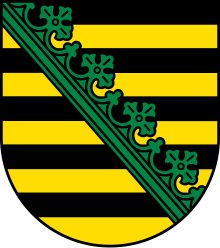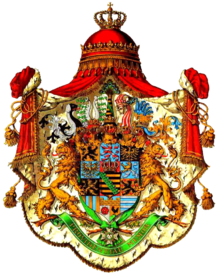State coat of arms of Saxony
The Coat of arms of Saxony is as follows described : the country's coat of arms shows in nine shared by black and gold box, an obliquely right green Rautenkranz.
history

The origin of the coat of arms derives from the Counts of Ballenstedt from the Ascanians . Their coat of arms was also divided nine times by black and gold. Although the shield appeared as early as the 12th century, the green diamond wreath was not put on until around 1260. It is said to have been adopted after the Ascanian line Saxony-Wittenberg renounced its ancestral land in Lower Saxony (the Duchy of Saxony-Lauenburg ) and owes its shape to the Gothic architectural style. After the Saxon-Wittenberg line of the Askanians in the male line died out in 1422, the duchy and the Saxon electoral dignity were transferred to the Meissen line of the Wettins , the Margraves of Meißen , who also took over the coat of arms.
According to legend, the origin of the coat of arms is said to have taken place as follows: When Duke Bernhard from the House of Askania was appointed Duke of Saxony in place of the deposed Welf Heinrich the Lion , he appeared, as was customary at the time, at the solemn entry to the Court Day Carrying a shield in front of Emperor Friedrich I. On the shield he carried Ballenstedt's black and gold bars. Because of the heat of the sun, Emperor Barbarossa had a wreath of rue on his head. He took it off, hung it over Bernhard's shield and donated the Saxon coat of arms.
Today's national colors were introduced by Friedrich August I by ordinance in 1815. The Saxon troops should wrap their previously white cockades with an additional wide green ribbon to make them easier to distinguish. One of the first literary mentions of colors can be found in a song by Carl Hinkel .
The constitution of the Free State of Saxony describes the state symbols in Article 2. A special feature is paragraph 4, which allows other state symbols with equal status as follows:
"(4) In the settlement area of the Sorbs , in addition to the state colors and the state coat of arms, the colors and coat of arms of the Sorbs , in the Silesian part of the country the colors and the coat of arms of Lower Silesia can be used equally."
The Saxon state flag is white-green; the state service flag also bears the state coat of arms.
As in other countries, Saxony has a coat of arms . As this was often felt to be too modern, the country introduced another coat of arms in 2005. In contrast to the coat of arms, the coat of arms may be used by anyone without a permit.

Picture gallery

|

|

|

|
|
Coat of arms (for non-governmental use,
z. B. by associations and companies from Saxony) |
State service flag | Official coat of arms of the Saxon state parliament |
|
See also
- List of coats of arms in Saxony
- List of flags of German countries
- Heraldic sign
- Meissen lion
- Landsberg piles
Web links
Individual evidence
- ↑ REVOSax state law Saxony - Constitution. Retrieved June 11, 2020 .
- ^ Karl Peter Lepsius: Small writings, contributions to Thuringian-Saxon history and German art and antiquity . Third volume. Creutz, Magdeburg 1855, On the history of the Saxon coat of arms, p. 174-181 ( google.de ).


